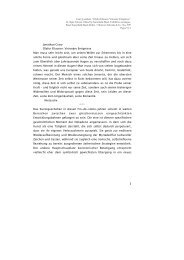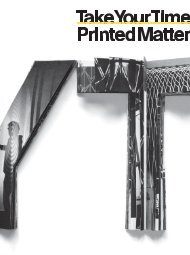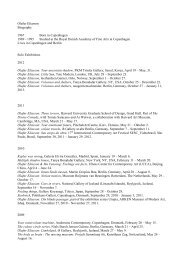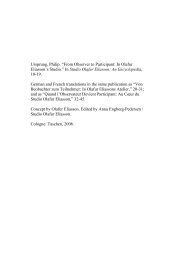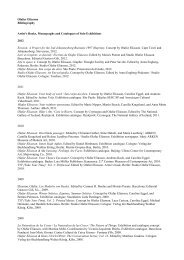Studio Olafur Eliasson
Studio Olafur Eliasson
Studio Olafur Eliasson
You also want an ePaper? Increase the reach of your titles
YUMPU automatically turns print PDFs into web optimized ePapers that Google loves.
Writings<br />
this dialogue with others but the studio pragmatically depends on<br />
it for its very vitality.<br />
Riding the S-Bahn on my journey home in the autumn of 2010, I<br />
reflect on the white fog of the experiment I witnessed during my first<br />
visit. 23 The experiment was for an installation that, like Your blind<br />
movement, has no spatial boundaries—a fitting example of the ethos<br />
of the entire studio itself. With seemingly no disciplinary or spatial<br />
boundaries whatsoever, <strong>Studio</strong> <strong>Olafur</strong> <strong>Eliasson</strong> continues to drive<br />
towards the transdisciplinary by incorporating skills and ideas from<br />
other fields, perpetually transforming as a structure.<br />
74 75<br />
<strong>Studio</strong> <strong>Olafur</strong> <strong>Eliasson</strong><br />
1 See the interview with Engberg-Pedersen.<br />
Also see the comments made by Caroline<br />
Jones on the role of the discourse worker<br />
in <strong>Studio</strong> <strong>Olafur</strong> <strong>Eliasson</strong>.<br />
2 Seminars include “Life in Space 1,”<br />
June 2006; “Life in Space 2,” June 2007;<br />
and “Life in Space 3,” May 2008, and<br />
their associated publications. See the<br />
comments by Jones on how, especially<br />
in <strong>Eliasson</strong>’s case, “any art writer has to<br />
become aware of how they are part of<br />
what [Walter] Benjamin theorized as the<br />
‘author as producer’ model when they<br />
write,” page 312.<br />
3 A partial list of visitors includes Daniel<br />
Birnbaum, Beatriz Colomina, Caroline<br />
Jones, Sanford Kwinter, and Mark Wigley.<br />
4 On the physical fabrication of <strong>Eliasson</strong>’s<br />
work, see the interview with Frank<br />
Haugwitz.<br />
5 For more on <strong>Eliasson</strong>’s mobile-studio see<br />
The Conversation Series: Hans Ulrich<br />
Obrist/<strong>Olafur</strong> <strong>Eliasson</strong> (Cologne: Verlag<br />
der Buchhandlung Walther König,<br />
2008), 93–122.<br />
6 Institut für Raumexperimente has not<br />
been factored into the current research<br />
on the pedagogical turn in art practice<br />
and curating—yet. For the most recent<br />
installment of this turn see Paul O’Neil<br />
and Mick Wilson, eds., Curating and the<br />
Pedagogical Turn (London/Amsterdam:<br />
Open Editions/de Appel, 2010). In<br />
terms of structure, Frederick Kiesler’s<br />
“design correlation laboratory” developed<br />
in the 1930 forms an appropriate<br />
analogy to the relationship between<br />
the school and <strong>Eliasson</strong>’s studio. See<br />
Stephen Phillips, “Toward a Research<br />
Practice: Frederick Kiesler’s Design-<br />
Correlation Laboratory,” Grey Room 38<br />
(Winter 2010): 92–93.<br />
7 See the interview with Eggel.<br />
8 Vito Acconci took part in the marathon.<br />
See the interview with him.<br />
9 Maurice Merleau-Ponty, The Phenomenology<br />
of Perception (London: Routledge,<br />
2002 [1945]), 248.<br />
10 On <strong>Eliasson</strong>’s relationship to architecture<br />
see Henry Urbach, “Surface Tensions:<br />
<strong>Olafur</strong> <strong>Eliasson</strong> and the Edge of Modern<br />
Architecture,” in Take Your Time: <strong>Olafur</strong><br />
<strong>Eliasson</strong>, ed. Madeleine Grynsztejn<br />
(San Francisco: San Francisco Museum<br />
of Modern Art, 2007). On the Light and<br />
Space artists, see Pamela M. Lee, “Your<br />
Light and Space,” in Take Your Time:<br />
<strong>Olafur</strong> <strong>Eliasson</strong>. And on the Soviet<br />
Constructivists, see Klaus Biesenbach<br />
and Roxana Marcoci, “Toward the Sun:<br />
<strong>Olafur</strong> <strong>Eliasson</strong>’s Protocinematic Vision,”<br />
in Take Your Time: <strong>Olafur</strong> <strong>Eliasson</strong>. See<br />
<strong>Eliasson</strong>’s comments on his resistance<br />
to the more narrow definition of design<br />
in terms of “lifestyle” and “styling” in<br />
Louise Schouwenberg, “A Change of<br />
Climate,” Frame 49 (March/April 2006).<br />
11 For more on this tendency see Rick<br />
Poynor, “Art’s Little Brother” (2005),<br />
in Design and Art—a heavily critical<br />
review of my DesignArt reprinted from<br />
Icon 23 (May 2005).<br />
12 In by far the longest essay on the role of<br />
the studio in <strong>Eliasson</strong>’s practice, Philip<br />
Ursprung, who has developed some of<br />
the most engaging writing on the contemporary<br />
studio, opposes the methods<br />
and aims of <strong>Eliasson</strong>’s work to those of<br />
design—repeating the usual hierarchy<br />
between art and design:<br />
<strong>Eliasson</strong> is part of a general social<br />
trend of recent years: namely, the<br />
increasing demand for art to articulate<br />
the things that surround us. We<br />
can call it “design” in the broadest<br />
sense of the word. It is a practice that<br />
transcends what is normally understood<br />
by the term “art.” It is also a<br />
practice that should not be confused<br />
with product design. Rather, it is a<br />
blueprint of our environment, of the<br />
way we move and behave; in fact, it<br />
is all about our life.<br />
See “From Observer to Participant:<br />
In <strong>Olafur</strong> <strong>Eliasson</strong>’s <strong>Studio</strong>,” in <strong>Studio</strong><br />
<strong>Olafur</strong> <strong>Eliasson</strong>: An Encyclopedia<br />
(Cologne: Taschen, 2008), 15. While<br />
the essay is impressive in scope,



